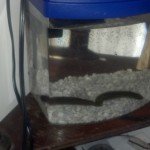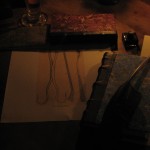Posted By Doctor Clift on January 19, 2012
Last year about this time I talked about Sippy, Gulpy, and Glugger, the newest members of the Doctor’s family. Sadly, when trying to feed them something from a domestic grocer (chicken livers), they met their demise. I take this as semi-proof that chicken livers in general are evil, but you can take it for whatever you’d like.
However, this past November, I was graced with new leeches* from the same individual (thank you to Miss Nelson for them, and for Mr. Miller for delivering), and now have 2 beautifully happy leeches in a nice tank, living a very happy life. Sippy and Glugger (yes I repeated names), like their counterparts, however, needed to eat as well, and so this time around I did some better homework.
Thanks to Miss L, who used to work at the Mercer Apothecary in Fredericksburg, VA (who has a ton of leeches), I was able to find out that they should just be given what they know best- blood. So off I went to the best place I knew to get blood- the local butcher. To their credit, Hemp’s Meats in Jefferson, MD didn’t flinch when I called asking when they were butchering in order for me to get some blood for my little guys. They actually were rather interested in the idea of me using the blood for something like this! So yesterday afternoon at lunchtime, I was able to procure several ounces of blood for my little suckers, and let them fill their gullets.

Lunchtime!!
As you can see, both leeches were very happy with the arterial blood that Hemp’s provided, and each earned their name respectively. Glugger finished his meal in about 30 minutes of continuous writing and sucking, and Sippy took his time, hiding in a different area of the bowl for about 2 and a half hours before filling himself full of the tasty ooze. To see what it looks like when they eat- you can click here. Yes, it really is that fascinating.
After glugger was finished, I put him back into his water tank to start working digesting and working off that meal. He had easily tripled in size, looking less like a small snake, and more like a vienna sausage now. You can see video of him trying to move around the tank here. He’s kinda waving to me almost in this video, which is kinda cute, in an “I think slimy things are neat” kinda way.
After some coaxing, and some moving around in the tub of red, Sippy finally found his favorite spot of the meal, and gorged himself as well. Once he started doing that, it only took him another 20 minutes of feeding before he too was as big as Gulpy. I put him back as well, and of course got a picture of them side by side in the tank. Note: their tank is only 1 gallon, so while it is impressive that they’re stretched out the whole way across, its also kinda small. According to my research on them, however, they can get pretty big, about 8-10 inches long at full growth.
All told, I estimate that the pair of leeches ate about 1-1.5 ounces of blood from the container, which isn’t bad! On average a leech will eat around 5-15ml of blood, so these guys are slightly on the overachiever side. The gang will need to be fed every 90 days or so. I’ve already warned the butcher that I would be calling again for more in the spring, and I may actually invest in more leeches. They’re actually very fascinating to have in the tank as pets (watching them dig in the rocks at the bottom of the tank is truly fascinating!), and it would be nice to start my own collection of leeches to bring to events. As it stands currently, I only bring out one at a time, in order to keep track of them and to make sure they’re not all traumatized at once. If I had a small pack of leeches (like 8 or so), then I may be more inclined to bring more in the future. But again, I can only really bring them out in the spring and fall, or in places where I’m air conditioned, so it may not be the most ideal thing to do. I’m debating whether or not Sippy or Gulpy will be making the trip to my first event of the season- Military Through the Ages in March.
Yes, this post isn’t really about 18th century medicine other than it has leeches in it, and the leeches were used in 18th century medicine. But alot of people at events have asked me if I have leeches, and if so, what I feed them to keep them sustained. Other people have offered themselves up to feed the leeches, and while I appreciate the sentiment, I am unable to take you up on that offer. Leeches can carry blood born pathogens (just like mosquitos carry West Nile, etc.) In this day and age when sometimes inquisitiveness becomes “hands on experimentation,” I want to make sure that these little guys can’t really do any damage if they were to attach to someone by accident. I personally take universal precautions when pulling them in and out of the tank for feeding and transport to events (rubber gloves etc so I don’t let them have me for lunch.), and keep them in their jar at events to swim around and look “cute” for everyone. Plus, it can occassionally take 48 hours or more for a leech bite site to cease bleeding because of the hirudin (the anticoagulant), and there’s a slight risk of an anaphylactic reaction to it as well, and no one wants that.
I think the most interesting thing for me is seeing how they’re going to shrink back down from their hugely engorged states. I’ve seen Glugger stretch out a couple of times, and parts of him are skinny when he does that, but there’s still a fair amount of blood in there for him to digest. But for the time being, they’re my little green sausages, and I’m very content in the knowledge that they fed well and will hopefully continue to grow and thrive as members of the entourage.
*Author’s side note: I was given 3 leeches by Miss Nelson, but only have 2. The general consensus is that Gulpy has run off to run for public office. Vote Gulpy in 2012.
Category: Uncategorized |
No Comments »
Tags:






